Understanding the basics of fundamental analysis is essential for any investor aiming to make informed financial decisions. This method focuses on evaluating a company’s intrinsic value by analyzing key financial metrics and economic factors. Unlike technical analysis, which emphasizes price trends and patterns, fundamental analysis delves deep into a company’s financial health, assessing factors like revenue, profit margins, and market position.
Fundamental analysis is particularly valuable for long-term investors who aim to invest in companies with solid fundamentals. By examining aspects such as earnings, dividends, and cash flow, investors can determine whether a stock is undervalued or overvalued. The goal is to predict future performance based on a detailed understanding of the company’s current and past financial performance.
Table of Contents
How Does Fundamental Analysis Differ from Technical Analysis?
Fundamental analysis and technical analysis are the two primary methods used by investors to evaluate stocks and make investment decisions. While both aim to help investors forecast future price movements, they do so in distinctly different ways.
- Fundamental Analysis focuses on evaluating the intrinsic value of a company based on its financial statements, economic conditions, and management quality. Investors examine factors such as earnings, assets, liabilities, and overall market conditions to make informed decisions about a company’s value.
- Technical Analysis, on the other hand, emphasizes studying past market data, particularly price and volume, to predict future price movements. Technical analysts use charts, trends, and indicators like moving averages or momentum oscillators to identify trading opportunities.
Key Differences:
- Time Frame: Fundamental analysis is suited for long-term investments, while technical analysis often focuses on short-term price movements.
- Focus: Fundamental analysis looks at the company’s financial health, while technical analysis examines market trends.
- Data Used: Fundamental analysis relies on financial statements and economic data, while technical analysis is rooted in price action and volume data.
Why is Fundamental Analysis Important for Investors?
Fundamental analysis plays a crucial role in helping investors identify potential investments that are undervalued or have strong growth prospects. By conducting a thorough assessment of a company’s financials, investors can make well-informed decisions that lead to better long-term results.
The primary objective of fundamental analysis is to determine whether a stock’s market price is aligned with its intrinsic value. If the stock is trading below its intrinsic value, it is considered undervalued, providing an opportunity for profit. Conversely, a stock trading above its intrinsic value may be overvalued, indicating potential risk.
Key Benefits for Investors:
- Informed Decision-Making: Helps investors make sound investment decisions by examining key financial metrics like earnings per share (EPS), debt-to-equity ratio, and return on equity (ROE).
- Long-Term Focus: Offers insights into the long-term health and sustainability of a company, making it ideal for long-term investors.
- Risk Management: Fundamental analysis also allows investors to avoid overhyped stocks that may lack the financial strength to back their valuation.
What Are the Key Components of Fundamental Analysis?
Fundamental analysis involves evaluating various components that reveal a company’s financial standing, competitive positioning, and future growth potential. These key components help in forming a holistic view of the company’s intrinsic value.
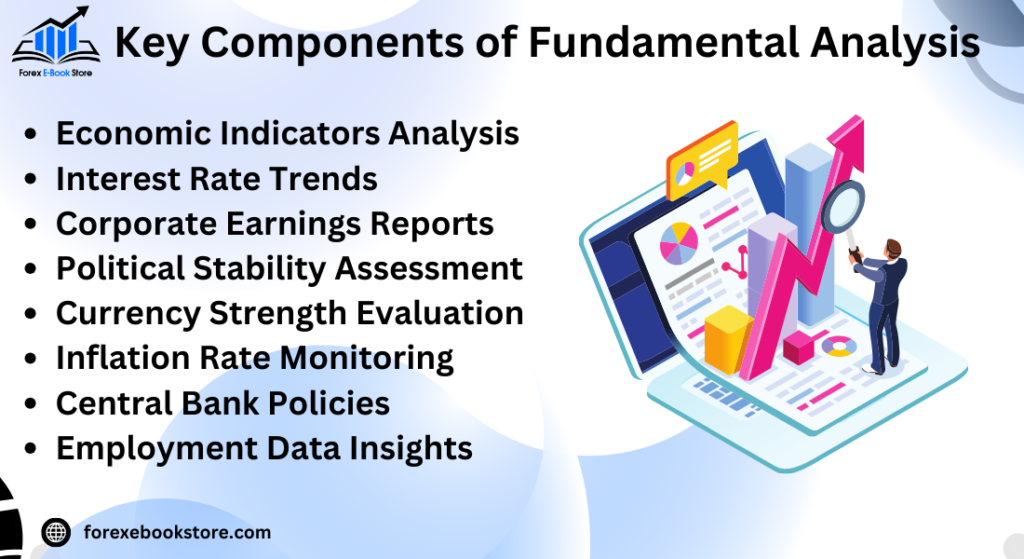
1. Financial Statements Analysis
The backbone of fundamental analysis lies in thoroughly examining a company’s financial statements, which are primarily the income statement, balance sheet, and cash flow statement. These documents provide a snapshot of the company’s profitability, liquidity, and financial health.
- Income Statement: Shows how much revenue a company generates and its net income, helping investors assess its profitability.
- Balance Sheet: Provides a view of the company’s assets and liabilities, indicating its financial stability.
- Cash Flow Statement: Shows how efficiently a company generates cash flow from its operations, critical for assessing liquidity and sustainability.
2. Economic Indicators
Investors also need to consider broader economic indicators such as interest rates, inflation, and employment rates. These factors can significantly influence a company’s growth prospects and, consequently, its stock performance.
3. Industry and Market Position
A company’s position in its industry and the overall market is another vital aspect of fundamental analysis. Competitive factors, market share, and barriers to entry can help determine whether a company is likely to succeed in the long term.
In Summary:
- Financial statements provide critical insights into profitability, liquidity, and financial strength.
- Economic conditions affect a company’s growth prospects.
- A company’s market position can reveal its competitive advantage or lack thereof.
How to Evaluate a Company’s Financial Statements?
Evaluating a company’s financial statements is a cornerstone of fundamental analysis. By analyzing the three main financial reports — the income statement, balance sheet, and cash flow statement — investors can gain a comprehensive understanding of a company’s financial health and operational efficiency.
1. Income Statement Analysis
The income statement reveals a company’s revenues, expenses, and profits over a specific period. It helps investors gauge whether the company is growing its revenue and controlling its costs.
- Revenue: Investors should look for consistent revenue growth, which indicates a company’s ability to expand its market presence.
- Net Income: This is the bottom line, showing the company’s profit after all expenses. A consistent increase in net income is a positive sign of financial health.
2. Balance Sheet Overview
The balance sheet provides a snapshot of a company’s assets, liabilities, and shareholder equity. This allows investors to assess the financial stability of the company.
- Assets: These include current assets (like cash and accounts receivable) and long-term assets (such as property and equipment).
- Liabilities: These are debts and obligations, including short-term and long-term liabilities.
- Equity: Shareholder equity represents the net value of the company after liabilities are subtracted from assets.
3. Cash Flow Statement Review
The cash flow statement shows how well a company generates cash to fund operations, repay debt, and expand its business.
- Operating Cash Flow: This reveals the cash generated from core business activities, indicating whether the company can sustain its operations without relying on external financing.
- Free Cash Flow: After accounting for capital expenditures, free cash flow shows the cash available for dividends, investments, or debt repayment.
What Role Do Economic Indicators Play in Fundamental Analysis?
Economic indicators are essential tools in fundamental analysis as they provide context to a company’s performance in relation to broader economic conditions. These indicators, such as GDP growth, inflation rates, and interest rates, offer insight into the overall health of the economy, which directly influences a company’s future prospects.
Key Economic Indicators to Consider:
- Gross Domestic Product (GDP): GDP measures the total value of goods and services produced in a country. A growing GDP suggests a strong economy, which typically benefits companies by increasing demand for their products and services.
- Inflation Rates: High inflation can erode purchasing power and increase costs for companies. Investors should assess how well a company can pass on these costs to customers without losing business.
- Interest Rates: Interest rates set by central banks affect borrowing costs for companies. Rising interest rates can make borrowing more expensive, which may reduce profits for companies reliant on debt financing.
Impact on Fundamental Analysis
- Company Valuation: Economic indicators can affect how investors value a company. For example, in a low-interest-rate environment, investors may be more willing to invest in growth stocks as borrowing costs are lower.
- Sector-Specific Effects: Certain sectors are more sensitive to specific indicators. For instance, manufacturing and construction companies are closely tied to GDP growth, while financial institutions are affected by interest rates.
How to Analyze a Company’s Earnings Reports?
Earnings reports are one of the most important sources of information for investors conducting fundamental analysis. Released quarterly, these reports provide insight into a company’s performance over the previous three months, allowing investors to track trends and adjust their investment strategies accordingly.
Key Components of an Earnings Report
- Earnings Per Share (EPS): This metric shows how much profit a company generates per share of stock. A growing EPS over time is a sign of strong financial performance.
- Revenue: Earnings reports include both top-line (revenue) and bottom-line (net income) figures. Consistent revenue growth indicates a company’s ability to attract and retain customers.
- Guidance: Companies often provide forward-looking statements, or guidance, in their earnings reports. Positive guidance suggests that management expects strong future performance, which can boost investor confidence.
How to Interpret Earnings Reports
Investors should look beyond the headline numbers and dig deeper into the details of an earnings report:
- Compare with Analyst Expectations: The stock market often reacts strongly to whether a company beats or misses analysts’ expectations. A company that consistently exceeds expectations is likely to see its stock price rise.
- Examine Margins: Profit margins (gross, operating, and net margins) show how efficiently a company is managing its costs. A decline in margins could signal rising costs or pricing pressure from competitors.
In Summary:
- Earnings per share and revenue are key indicators of company performance.
- Profit margins provide insight into how efficiently a company operates.
- Guidance gives investors a sense of future expectations.
What is the Importance of Cash Flow in Fundamental Analysis?
Cash flow is a critical component in fundamental analysis as it reveals the actual liquidity of a company, showing how much cash is generated or consumed during a specific period. Unlike profits, which can be manipulated through accounting methods, cash flow provides a more straightforward view of a company’s financial health.
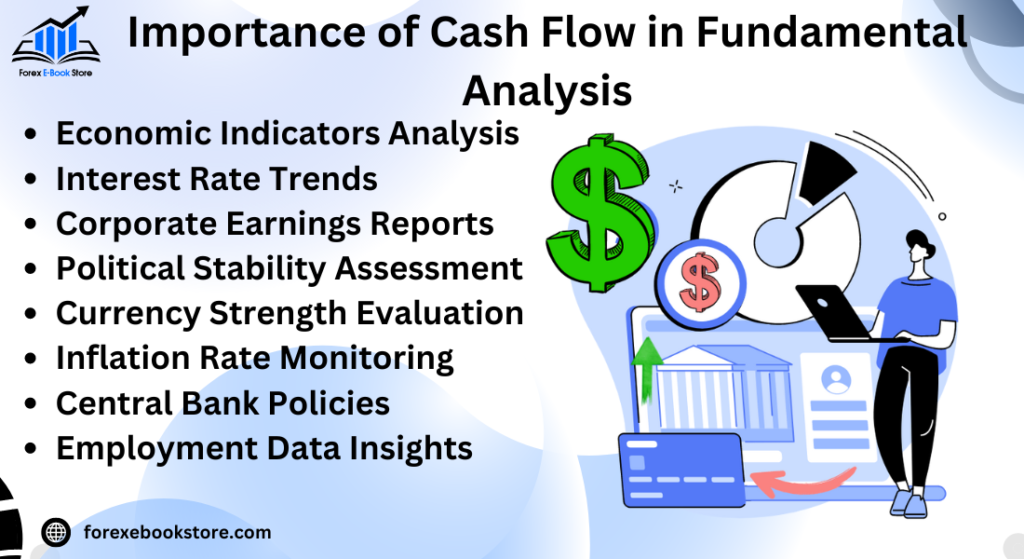
Types of Cash Flow
There are three primary types of cash flow that investors should focus on:
- Operating Cash Flow (OCF): This shows the cash a company generates from its core business operations. It’s a reliable indicator of a company’s ability to sustain itself without external financing.
- Investing Cash Flow: This reveals cash used for investment activities, such as purchasing new equipment or acquiring other companies. High investing cash flow could signal expansion or increased capital expenditures.
- Financing Cash Flow: This reflects how a company finances its operations, including cash raised from issuing stock, taking on debt, or repaying debt.
Why Cash Flow is Important for Investors
- Solvency Check: Positive operating cash flow indicates that a company can cover its liabilities and sustain operations without relying on debt or outside funding.
- Investment Potential: Strong cash flow gives companies the flexibility to reinvest in their business, pay dividends, or make acquisitions, all of which can enhance shareholder value.
- Sustainability of Profits: Sometimes, a company may report high earnings, but if cash flow is weak, it could signal underlying issues. In such cases, relying solely on earnings per share (EPS) might be misleading, making cash flow a crucial part of the analysis.
How to Assess a Company’s Competitive Advantage?
A company’s competitive advantage is the edge it holds over its competitors, which allows it to generate higher returns, gain market share, and achieve sustainable growth. In fundamental analysis, understanding a company’s competitive advantage helps investors determine if the company can maintain profitability in the long run.
Types of Competitive Advantage
- Cost Leadership: Companies with a cost advantage can produce goods or services at a lower cost than competitors, allowing them to offer lower prices or enjoy higher margins. For instance, companies like Walmart and Amazon benefit from economies of scale, reducing costs while maintaining large profit margins.
- Differentiation: Companies that offer unique products or services that competitors cannot easily replicate enjoy a differentiation advantage. Brands like Apple and Tesla have a strong reputation for innovation, making them less susceptible to price competition.
Assessing Competitive Advantage
- Market Share: One way to assess a company’s competitive advantage is by examining its market share. A growing or dominant market share often indicates that a company is successfully outpacing competitors.
- Barriers to Entry: Strong competitive advantages often come with high barriers to entry. Industries that require significant capital investment or proprietary technology provide a moat that protects market leaders from new competitors.
- Brand Strength: A company’s brand reputation, customer loyalty, and ability to command higher prices can also reflect its competitive advantage.
What is the Price-to-Earnings (P/E) Ratio and How is it Used?
The price-to-earnings (P/E) ratio is one of the most widely used valuation metrics in fundamental analysis. It compares a company’s stock price to its earnings per share (EPS), providing investors with a quick way to gauge how much they are paying for a company’s profits.
How to Calculate the P/E Ratio
The P/E ratio is calculated using the formula:

For example, if a company’s stock is trading at $100 per share and its EPS is $5, its P/E ratio would be 20. This means investors are willing to pay $20 for every dollar of earnings.
Interpreting the P/E Ratio
- High P/E Ratio: A high P/E ratio suggests that the market expects high future growth from the company. Investors are willing to pay a premium for the stock because they anticipate that earnings will increase significantly over time. However, a high P/E can also indicate that the stock is overvalued.
- Low P/E Ratio: A low P/E ratio may suggest that the stock is undervalued or that the market has lower growth expectations for the company. For value investors, a low P/E ratio might represent a buying opportunity if they believe the market has mispriced the stock.
Limitations of the P/E Ratio
- Sector-Specific Benchmarks: It’s essential to compare the P/E ratio of a company with its industry peers, as different sectors have varying growth expectations and average P/E ratios.
- Earnings Volatility: The P/E ratio can be misleading for companies with highly volatile earnings or those in cyclical industries. In such cases, other metrics like the price-to-book ratio or enterprise value to EBITDA (EV/EBITDA) may provide a more reliable valuation.
How to Use the Price-to-Book (P/B) Ratio in Stock Evaluation?
The Price-to-Book (P/B) ratio is a valuation metric that compares a company’s market value to its book value. It helps investors determine whether a stock is undervalued or overvalued by comparing the market price with the company’s tangible assets.
How to Calculate the P/B Ratio
The P/B ratio is calculated using the formula:

For example, if a company’s stock is trading at $50 per share and its book value per share is $25, the P/B ratio is 2. This means investors are willing to pay twice the company’s book value for the stock.
Interpreting the P/B Ratio
- Low P/B Ratio: A P/B ratio of less than 1 may indicate that the stock is undervalued, meaning the company’s assets are worth more than its market price. This can be an attractive buy signal for value investors.
- High P/B Ratio: A high P/B ratio suggests that the stock may be overvalued, or that investors expect high future growth or profitability. However, it can also indicate that the company holds intangible assets, such as brand value or intellectual property, not reflected in the book value.
Limitations of the P/B Ratio:
- Industry Variation: P/B ratios vary widely between industries. For example, technology companies may have higher P/B ratios due to significant intangible assets, while manufacturing companies often have lower ratios.
- Tangible Assets: The P/B ratio only considers tangible assets. For companies with substantial intangible assets, such as tech firms, this metric may undervalue the company.
What is the Significance of Dividend Yield in Fundamental Analysis?
Dividend yield is a key metric for income-focused investors. It measures the income generated by a stock in the form of dividends relative to its price. High dividend yields are often attractive to investors seeking a steady income stream, while low or no dividend yields can indicate that a company is reinvesting profits for growth.
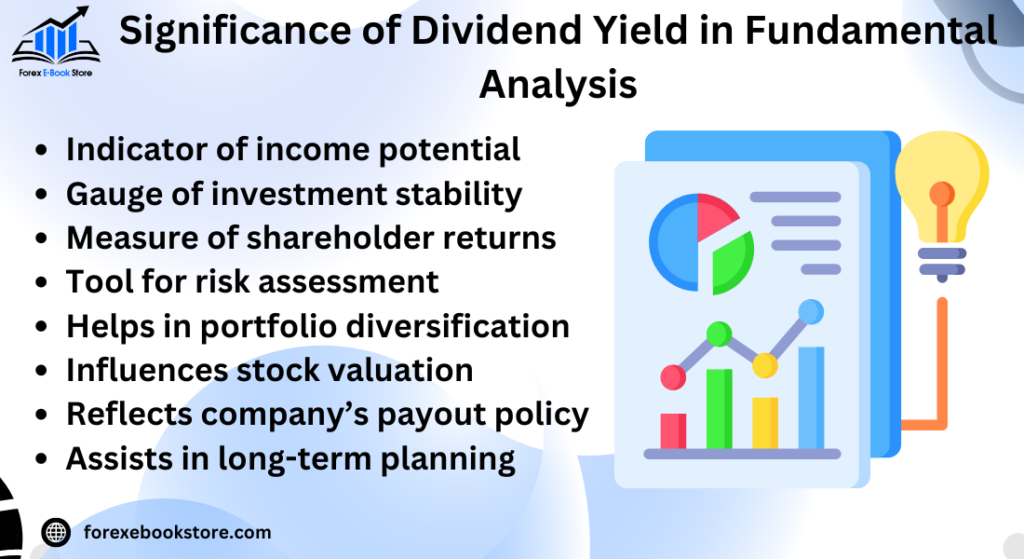
How to Calculate Dividend Yield
The dividend yield is calculated using the formula:

For example, if a company pays an annual dividend of $4 per share and its stock price is $100, the dividend yield is 4%.
Interpreting Dividend Yield
- High Dividend Yield: A high dividend yield may indicate that a stock is undervalued, as the price is low relative to the dividend payout. However, a very high yield can also be a red flag, indicating that the company is facing financial challenges and its stock price has dropped.
- Low Dividend Yield: A low or no dividend yield suggests that the company is either overvalued or reinvesting profits to fuel future growth. Growth companies, such as tech firms, often have lower dividend yields but higher potential for capital appreciation.
Why Dividend Yield Matters:
- Steady Income: Dividend yield is particularly significant for income investors who prioritize consistent returns through dividends rather than capital appreciation.
- Company Stability: Regular and stable dividends often indicate a financially healthy and stable company, especially for blue-chip stocks with a long history of dividend payments.
How Do Interest Rates Impact Fundamental Analysis?
Interest rates play a crucial role in fundamental analysis as they directly affect both a company’s cost of borrowing and the overall economy. Central banks, like the Federal Reserve in the U.S., adjust interest rates to manage inflation, promote economic growth, and influence spending.
Impact of Rising Interest Rates
When interest rates increase:
- Higher Borrowing Costs: Companies that rely on debt to finance operations or expansion may face higher interest expenses, which can reduce profitability.
- Lower Consumer Spending: Higher interest rates make loans and credit more expensive for consumers, potentially reducing demand for a company’s products or services.
Key Effects of Rising Interest Rates:
- Debt-Heavy Companies: Companies with substantial debt are particularly vulnerable to rising interest rates. Their interest expenses increase, which can eat into profits.
- Valuation Impact: Higher interest rates can lead to a lower valuation for stocks. This is because future cash flows, which are used to determine a company’s intrinsic value, are discounted at a higher rate, reducing the present value of those cash flows.
Impact of Falling Interest Rates
When interest rates decrease:
- Lower Borrowing Costs: Companies can take advantage of cheaper credit to expand operations or invest in growth opportunities, leading to higher profits.
- Increased Consumer Spending: Lower interest rates often encourage consumer spending, benefiting companies across various sectors by boosting demand.
Key Effects of Falling Interest Rates:
- Growth Opportunities: Lower rates typically benefit growth-oriented companies that require significant capital investment. These firms can borrow more cheaply, enhancing their ability to invest in expansion.
- Stock Valuation: Decreasing rates generally lead to higher valuations, as future cash flows are discounted at a lower rate, increasing their present value.
What is Discounted Cash Flow (DCF) Analysis?
The Discounted Cash Flow (DCF) analysis is a fundamental valuation method that estimates the value of an investment based on its expected future cash flows. This approach is widely used in fundamental analysis to determine whether a stock is undervalued or overvalued by calculating the present value of its future cash flows.
How Does DCF Work?
The DCF analysis involves two main steps:
- Estimating Future Cash Flows: This requires projecting a company’s free cash flow for several years into the future, often 5-10 years. Free cash flow represents the cash generated after deducting capital expenditures from operating cash flow.
- Discounting to Present Value: Once future cash flows are estimated, they are discounted to their present value using the discount rate (often the company’s weighted average cost of capital (WACC)). The formula for DCF is:

Where:
- CF = Cash Flow for each future period
- r = Discount rate
- n = Number of periods
Why Use DCF Analysis?
- Intrinsic Value: The DCF method helps investors determine the intrinsic value of a company, independent of market fluctuations. If the intrinsic value is higher than the current stock price, the stock is considered undervalued.
- Long-Term Focus: DCF analysis focuses on a company’s long-term potential, making it especially useful for investors seeking sustainable growth.
- Risk Assessment: By discounting future cash flows, investors can account for the time value of money and the associated risks with future earnings.
Limitations of DCF Analysis:
- Forecasting Risk: The accuracy of the DCF model heavily depends on the reliability of future cash flow estimates, which are uncertain and subject to market changes.
- Sensitive to Assumptions: Small changes in the discount rate or cash flow estimates can significantly alter the outcome of the DCF analysis.
How to Conduct a SWOT Analysis for Fundamental Analysis?
A SWOT analysis (Strengths, Weaknesses, Opportunities, and Threats) is a strategic tool used in fundamental analysis to evaluate a company’s competitive positioning and internal and external factors that may impact its future performance. This qualitative approach complements quantitative metrics like financial ratios and valuation models.
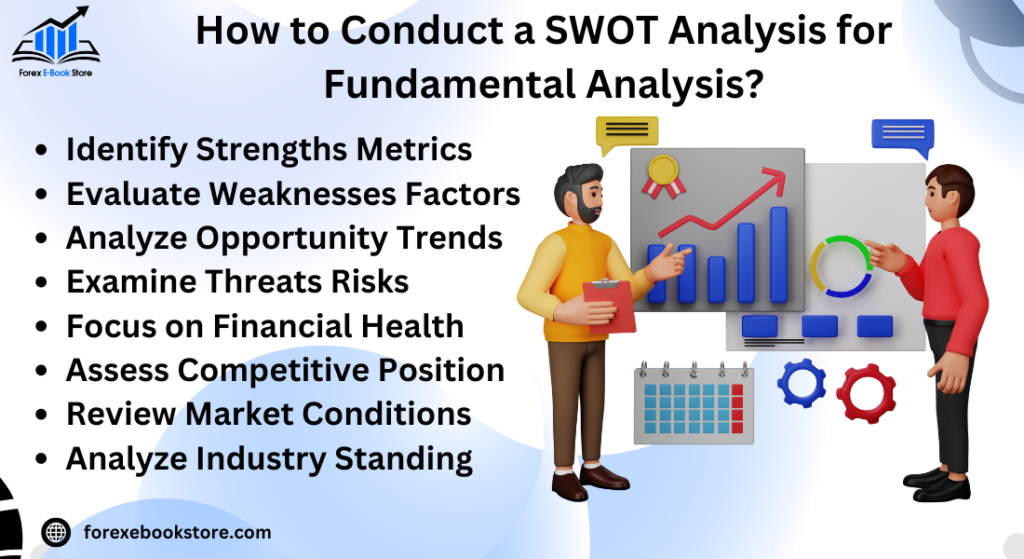
1. Strengths
Strengths represent a company’s competitive advantages and core competencies that allow it to outperform competitors. These might include:
- Strong Brand Recognition: A well-established brand like Apple or Coca-Cola can command premium pricing and customer loyalty.
- Robust Financials: Consistent revenue growth, positive cash flow, and strong profit margins are key strengths.
2. Weaknesses
Weaknesses are internal factors that put the company at a disadvantage, including:
- High Debt Levels: Companies with high leverage face significant risks, particularly in rising interest rate environments.
- Operational Inefficiencies: Poor supply chain management or high production costs can lead to reduced profit margins.
3. Opportunities
Opportunities refer to external factors that a company can capitalize on to grow:
- Market Expansion: Entering new geographic markets or launching new product lines can provide significant growth opportunities.
- Technological Innovation: Companies investing in cutting-edge technologies can stay ahead of the competition and create new revenue streams.
4. Threats
Threats are external risks that could harm the company’s performance:
- Competitive Pressure: Aggressive competitors or new market entrants can erode a company’s market share.
- Regulatory Changes: New government regulations can impact profitability, especially in industries like healthcare and finance.
Why SWOT Analysis Matters for Investors:
- Holistic View: SWOT analysis provides a well-rounded picture of a company’s internal and external environment, helping investors assess the risks and opportunities.
- Decision-Making Aid: By understanding the strengths and weaknesses, investors can make informed decisions on whether a company is likely to sustain competitive advantages and deliver returns.
What Are the Common Mistakes to Avoid in Fundamental Analysis?
While fundamental analysis is a powerful tool for making informed investment decisions, there are common mistakes that can lead to incorrect valuations and suboptimal investment outcomes. Recognizing and avoiding these errors is key to achieving better results.
1. Overemphasis on a Single Metric
Relying too heavily on a single financial metric, such as the P/E ratio or EPS, can lead to an incomplete analysis. No single metric tells the full story of a company’s financial health or future prospects.
- Balance of Metrics: Investors should use a combination of valuation ratios (P/E, P/B, EV/EBITDA), profitability indicators (ROE, ROA), and liquidity ratios to get a comprehensive picture.
- Industry Context: Some metrics may be more relevant in specific industries. For example, the P/B ratio is more meaningful in asset-heavy sectors like finance, while tech companies may require a focus on cash flow or revenue growth.
2. Ignoring Qualitative Factors
Quantitative analysis is crucial, but overlooking qualitative factors such as management quality, corporate governance, and industry trends can be detrimental to long-term investments.
- Management’s Track Record: A company with strong financials but poor management may struggle to sustain growth or navigate industry challenges.
- Industry Trends: Failing to consider changes in consumer behavior, technology, or regulatory environments can lead to misguided investment decisions.
3. Overlooking Economic and Market Conditions
Fundamental analysis focuses on the company’s financial health, but broader macroeconomic factors like interest rates, inflation, and GDP growth can also impact stock prices.
- Market Timing: An otherwise healthy company may suffer in a recession or economic downturn, making it essential to account for external economic conditions.
- Sector Sensitivity: Certain sectors are more sensitive to economic cycles, and ignoring these dynamics can lead to inaccurate valuations.
In Summary:
- Use multiple metrics for a well-rounded evaluation.
- Consider both quantitative and qualitative factors in your analysis.
- Stay informed about economic and industry trends to avoid market surprises.
How to Integrate Qualitative Factors into Fundamental Analysis?
In fundamental analysis, it’s not enough to rely solely on quantitative data like financial ratios and earnings reports. Qualitative factors play an equally important role in understanding the overall health and future potential of a company. These factors are not directly measurable but significantly influence a company’s long-term performance.
1. Management Quality
The effectiveness of a company’s leadership is one of the most critical qualitative factors. A strong management team with a proven track record of success can steer a company through tough market conditions and capitalize on growth opportunities.
- Leadership Vision: Look for executives with a clear and strategic vision for the company’s future. Companies like Amazon and Tesla have thrived due to visionary leaders who are not only focused on financials but also on innovation and growth.
- Experience and Track Record: Assess the management’s experience and previous success in managing companies. A management team with a history of creating shareholder value is often a good sign.
2. Corporate Governance
Good corporate governance ensures that a company operates ethically and in the best interest of its shareholders. Poor governance can lead to scandals, regulatory fines, and damage to a company’s reputation.
- Transparency: A company that practices transparent reporting and communicates effectively with shareholders is more likely to be trusted by investors.
- Board Independence: A strong and independent board of directors can provide effective oversight and prevent conflicts of interest.
3. Brand Value and Competitive Moat
A company’s brand strength and competitive moat are also important qualitative factors. Companies with strong brands often have a loyal customer base and can command higher prices for their products.
- Customer Loyalty: Look for companies that have built strong, lasting relationships with their customers, like Apple and Nike.
- Moat: A competitive moat, such as proprietary technology or exclusive distribution channels, can protect a company from competitors and create long-term advantages.
What Tools and Software Are Best for Conducting Fundamental Analysis?
With the growing complexity of stock markets and data-driven decisions, using the right tools and software can significantly enhance the accuracy and efficiency of fundamental analysis. These tools help investors gather financial data, analyze trends, and make informed decisions.
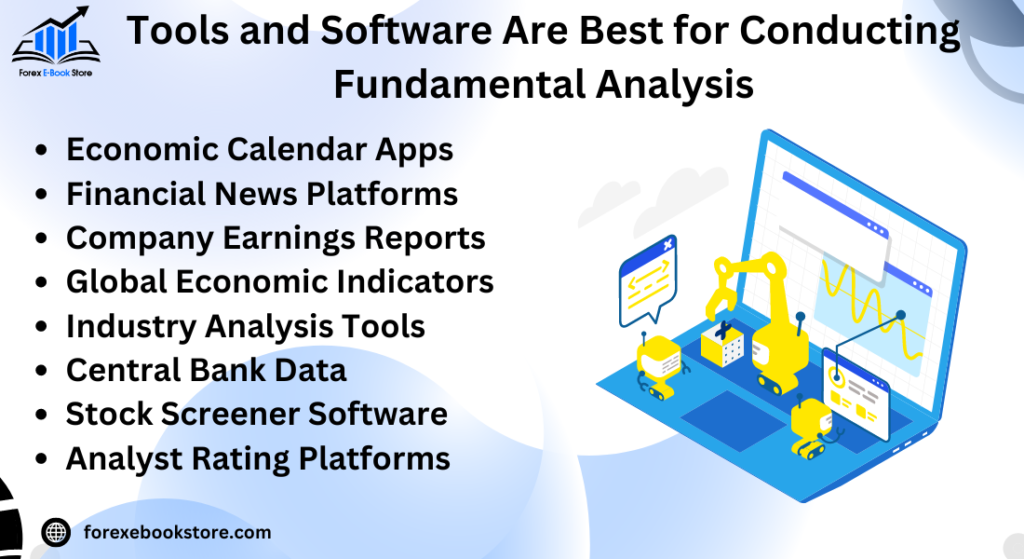
1. Financial Data Platforms
Financial data platforms offer comprehensive access to financial statements, earnings reports, and historical data for thousands of companies.
- Bloomberg Terminal: A professional-grade tool that provides real-time data, news, and analytics for investors. It offers in-depth coverage of financial metrics, stock prices, and news from around the world.
- Yahoo Finance: A free tool that provides detailed financial reports, historical stock data, and basic valuation metrics like P/E ratio and dividend yield. It’s suitable for beginners and individual investors.
2. Stock Screening Tools
Stock screeners help investors filter stocks based on specific criteria such as valuation, profitability, or growth potential.
- Finviz: This tool offers powerful filtering options, enabling users to screen stocks based on criteria like market cap, debt-to-equity ratio, and profit margin. It’s particularly useful for identifying undervalued or overvalued stocks.
- Morningstar: A trusted name in the investment world, Morningstar provides both qualitative and quantitative analysis. It offers stock ratings, company reports, and investment research tools.
3. Discounted Cash Flow (DCF) Calculators
DCF calculators allow investors to estimate the intrinsic value of a stock based on future cash flows.
- GuruFocus DCF Calculator: A user-friendly tool that simplifies the DCF model. Investors can input projected cash flows and the discount rate to calculate a company’s intrinsic value.
- Simply Wall Street: This platform visually represents the DCF model, allowing even novice investors to understand how the company’s future performance translates into current value.
How to Use Fundamental Analysis to Build a Long-Term Investment Portfolio?
Fundamental analysis is a powerful tool for building a long-term investment portfolio. By focusing on a company’s financial health, profitability, and growth potential, investors can create a portfolio that delivers steady returns while minimizing risk.
1. Focus on High-Quality Companies
When building a long-term portfolio, the goal is to invest in companies that exhibit strong fundamentals, including robust cash flow, low debt levels, and sustainable competitive advantages.
- Consistent Revenue Growth: Look for companies that have demonstrated consistent growth in revenue and earnings over time. These companies are more likely to continue growing in the future.
- Low Debt-to-Equity Ratio: High debt levels can increase a company’s risk, especially during economic downturns. A low debt-to-equity ratio indicates a strong balance sheet and less reliance on borrowing.
2. Diversification Across Sectors
Diversifying your portfolio across different sectors helps mitigate risks. Economic downturns and market cycles affect industries differently, so having a mix of sectors provides a buffer.
- Sector Rotation: Consider rotating into different sectors based on economic conditions. For instance, defensive sectors like healthcare and consumer staples perform better during recessions, while cyclical sectors like technology and industrials excel during economic expansions.
- Global Diversification: Don’t limit your investments to one country. Consider global diversification by investing in international stocks to benefit from growth in emerging markets and global trends.
3. Regularly Review and Rebalance
Even a well-constructed portfolio requires regular monitoring and rebalancing to ensure it stays aligned with your investment goals.
- Review Financial Health: Periodically review the financial health of your portfolio companies. Changes in cash flow, profitability, or management strategy can affect long-term performance.
- Rebalance to Maintain Allocation: As some stocks in your portfolio outperform others, it’s important to rebalance to maintain your desired allocation. This prevents your portfolio from becoming overly concentrated in one sector or company.
Conclusion
In conclusion, understanding the Basics of Fundamental Analysis is crucial for investors looking to evaluate a company’s true value by analyzing its financial health, economic conditions, and qualitative factors like management quality and competitive advantages. This long-term investment strategy helps identify undervalued stocks and assess their growth potential, providing a solid foundation for making informed investment decisions. By focusing on financial statements, cash flow, and intrinsic value, fundamental analysis ensures a comprehensive view of a company’s sustainability and profitability.
While Fundamental Analysis focuses on evaluating a company’s underlying financial strength, the Basics of Technical Analysis offer a complementary approach by analyzing price movements, trends, and patterns. Investors often use Technical Analysis for short-term decisions, as it provides insights into market sentiment and stock price trends. By interrelating both strategies, investors can gain a holistic view of market opportunities, combining the deep insights of fundamental analysis with the trend-spotting power of technical analysis to make balanced investment decisions.












